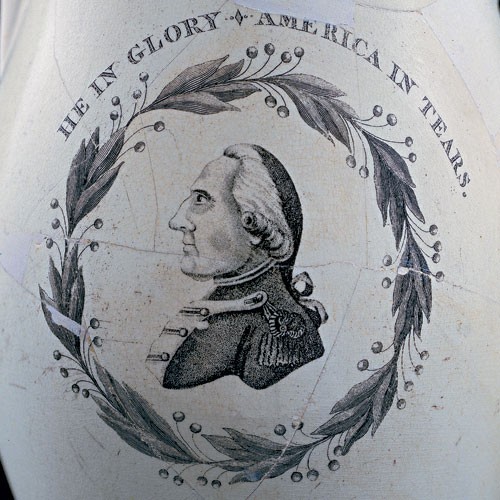
Detail of the pitcher illustrated in fig. 9. (Unless otherwise noted, all objects are from the collection of the Alexandria Archaeology Museum; unless otherwise noted, all photos by Gavin Ashworth.) This George Washington cartouche adorns a creamware mourning pitcher that was recovered from an archaeological site in Alexandria.
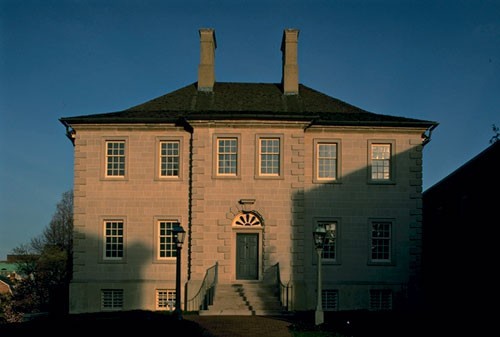
The Carlyle House, 121 North Fairfax Street, Alexandria, Virginia. (Courtesy, Office of Historic Alexandria; photo, Eric Kvalsvik.) Now a museum operated by the Northern Virginia Park Authority, Braddock headquartered here in 1755.
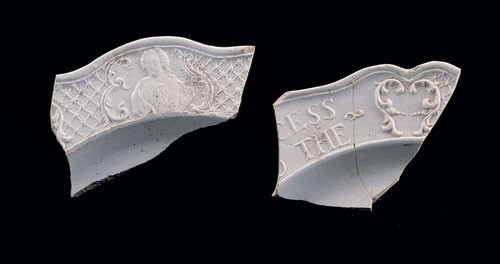
Plate fragments, England, ca. 1758. White salt-glazed stoneware. D. 9". The plate bore a bust of Frederick the Great and the slogan “SUCCESS TO THE KING OF PRUSSIA.” Beginning in 1758 the British supported Prussia against the Austrians and their French allies. This plate was owned by a family residing at 418 King Street, one block from the Carlyle House, and its fragments were discarded in a privy.

Pitcher fragment, England, ca. 1770s. Creamware. The scene depicts the death of General Wolfe, who successfully led British forces against the city of Quebec in 1759, during the French and Indian War.
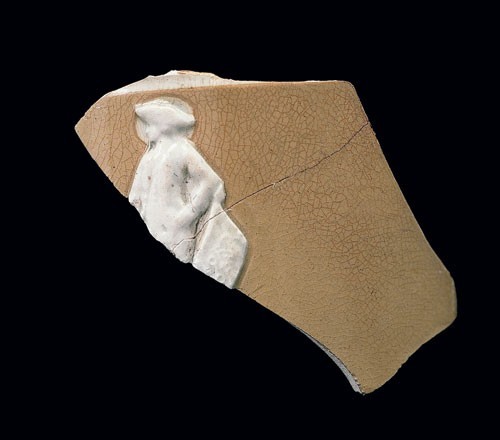
Tankard fragment, England, ca. 1782. Banded creamware with relief-molded appliqué of Lord Rodney. This fragment and others, discarded about 1790, were found at the bottom of a brick shaft at 109 South Fairfax Street, Alexandria, Virginia.

Replica of George Washington’s town house. (Courtesy, Office of Historic Alexandria; photo, Eric Kvalsvik.) Washington’s town house at 508 Cameron Street was built by 1769 and demolished in 1857. This replica was constructed on the same site in 1960. The Alexandria Gazette (June 7, 1851) described the original house as “a small frame house, the ascent to which is by a long narrow flight of steps. How simple the habits, how unostentatious the movements and the mansion of the deliverer of his country. . . . A stranger might pass and re-pass this house many times without taking any notice of it.” Although the house was often rented or lent to friends and family, Washington is thought to have spent some nights there in the early 1770s, and his letters give detailed orders for fencing the property, painting, and other repairs.
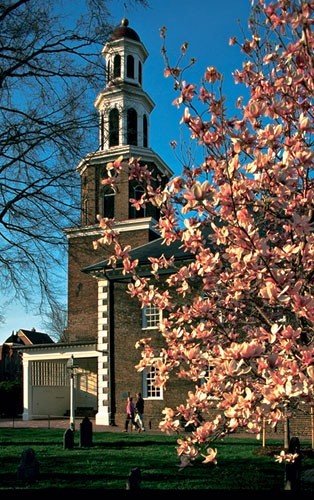
Christ Church, 118 North Washington Street, Alexandria, Virginia. (Courtesy, Office of Historic Alexandria; photo, Eric Kvalsvik.) George Washington’s family pew is preserved here. The church was constructed in 1773; the bell tower was added in 1818.

The ballroom at Gadsby’s Tavern Museum, 134 North Royal Street, Alexandria, Virginia. (Photo, Louise Krafft.) George and Martha Washington danced here at his Birthnight Balls in 1797 and 1798. The celebratory balls continued to be held long after his death, until the Civil War. Reenactments of the ball were held in 1932, on the bicentennial of Washington’s birth, and sporadically until the bicentennial of the nation, when the ball once again became an annual event.

Pitcher, attributed to the Herculaneum Pottery, Liverpool, ca. 1800. Creamware. H. 8 1/2". This black-rimmed mourning pitcher depicts Washington in profile surrounded by a wreath, with the words “HE IN GLORY· AMERICA IN TEARS.” On the reverse is an urn with the initials GW and the words “GEORGE WASHINGTON BORN FEB. 11, 1732 / GEN’L OF THE AMERICAN ARMIES 1775 / RESIGNED 1785 / PRESIDENT OF THE UNITED STATES 1789 / RESIGNED 1796 / GENERAL OF THE AMERICAN ARMIES 1798 / DIED UNIVERSALLY REGRETTED 14TH DECEMBER 1799.” Underneath the spout are the words “A MAN WITHOUT EXAMPLE / A PATRIOT WITHOUT REPROACH.”
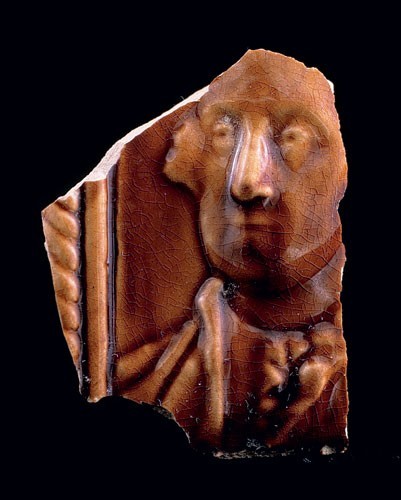
Teapot or pitcher fragment, United States, after 1845. Rockingham pottery. This sherd depicting George Washington was found during excavations at a home at 809 Duke Street, Alexandria, Virginia.
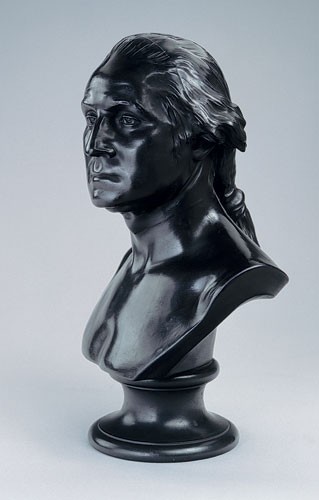
Bust of George Washington, Wedgwood, Staffordshire, 1875. Basalt stoneware. H. 18 1/4” (Courtesy, The Lyceum: Alexandria’s History Museum.) Inside the base are the letters xcd. This large bust was made in time to celebrate the nation’s centennial.
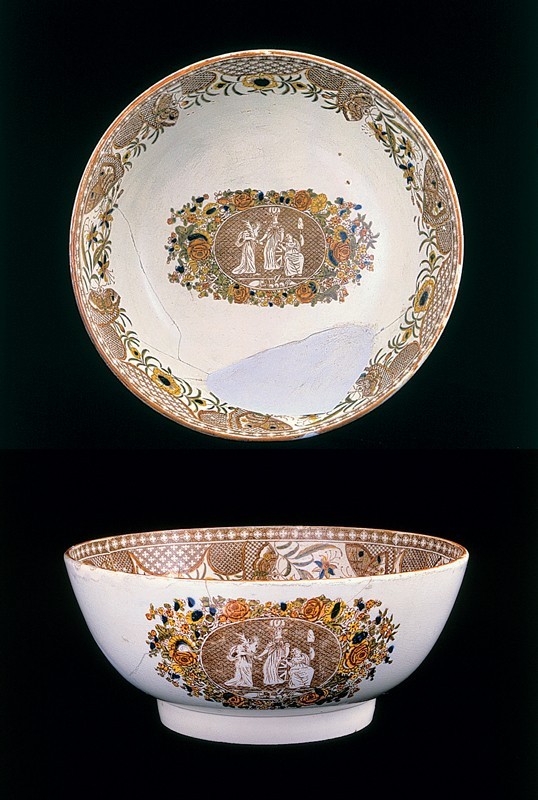
Punch bowl, England, ca. 1802. Pearlware. D. 10 1/4". Britannia is pictured with her shield. To her left is Victory, holding a palm frond, and seated to her right is France holding the Liberty Cap. The border includes a lovely butterfly motif. This punch bowl, made in celebration of the Treaty of Amiens, is from the household of Samuel Snowden, editor of the Alexandria Gazette. It was discarded in the 1820s, in a privy behind his home and office at 105 South Royal Street.

Cup and saucer, England, ca. 1802. Pearlware. D. of cup 3 5/8"; D. of saucer 5 1/2". Cups and saucers depicting Britannia came from the household of one of Snowden’s neighbors, on the 400 block of King Street.

Cup and saucer, England, ca. 1802. Pearlware. D. of cup 4"; D. of saucer 5". Cups, saucers, a cream pitcher, and a slop bowl from this tea set were found at the site of McKnight’s Tavern, at the corner of King and Royal Streets.
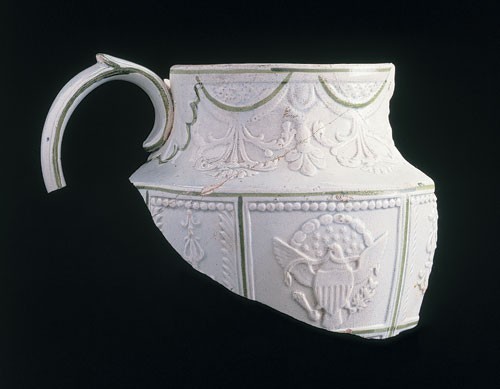
Pitcher fragment, attributed to Sowter and Company, Mexborough, Yorkshire, ca. 1800–1807. Castleford-style white feldspathic stoneware. This pitcher fragment, which bears the Great Seal of the United States, was found behind a house at 113 South Royal Street, Alexandria. It may have been discarded by the owner of McKnight’s Tavern, William H. McKnight, who moved there in 1816. The pitcher has the same molded relief pattern as a black stoneware teapot attributed to Sowter and Company.
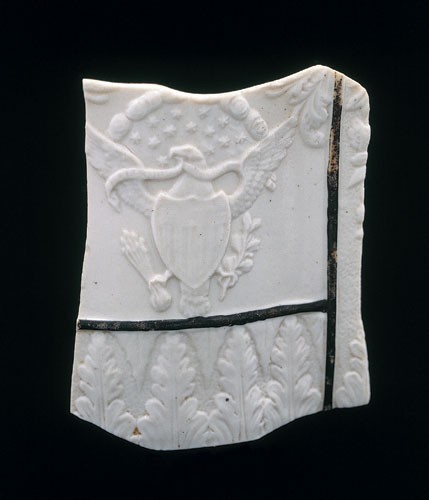
Pitcher fragment, attributed to the Leeds Pottery, ca. 1805-1807. Pearlware. The enameled lines that separate panels with molded relief decoration of the Great Seal are in the style of the Castleford Pottery, but the molded border on the pannels is identical to a Leeds sucrier in feldspathic stoneware. This fragment was found in a well behin the workshop of James Green, cabinetmaker, which stood in the interior of the square bounded by Fairdax, Prince, Royal, and King Streets and near the intersection of Royal and King Streets. The sherd was in a deposit relating to a fire in 1823 but probably had reached Alexandria before the Embargo of 1807.
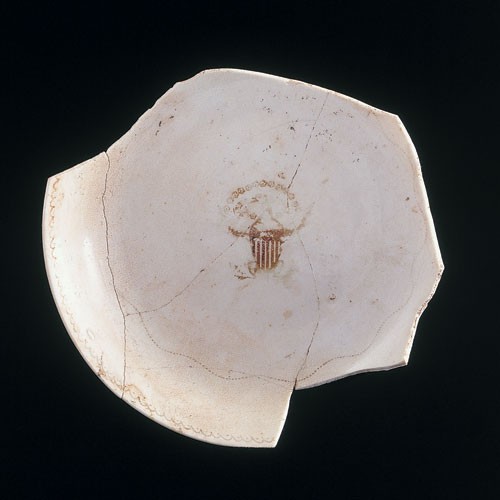
Saucer, England, possibly Enoch Wood and Sons, ca. 1784–1792. Soft-paste porcelain. D. 6". The Great Seal, with the motto “E PLURIBUS UNUM,” appears on this saucer, which was found in a well associated with Gadsby’s Tavern at 134 North Royal Street.
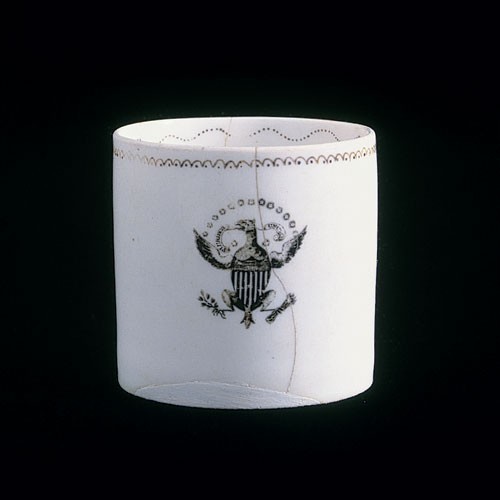
Coffee can, England, ca. 1795–1807. Bone china. H. 2 1/2". This cup, depicting the Great Seal, was found behind the James Green cabinet shop along with the Castleford-style pearlware sherd illustrated in fig. 16.
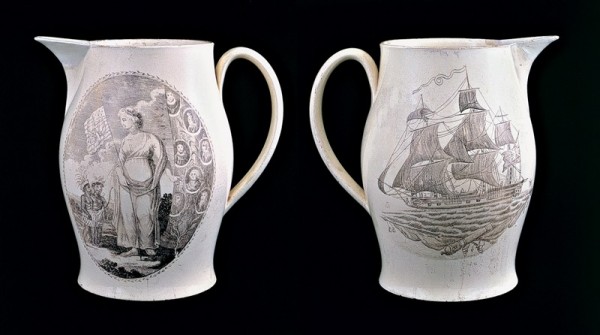
Pitcher, attributed to the Herculaneum Pottery, Liverpool, ca. 1800. Creamware. H. 8 1/2". In this reproduction of An Emblem of America, first published in 1799, a central figure holds an American flag. At left are two Indians and at right are portrait medallions of Christopher Columbus, Americus, Sir Walter Raleigh, Benjamin Franklin, George Washington, John Adams, and one unidentified person. On the reverse is a ship and cannon. Samuel Snowden, editor of the Alexandria Gazette, owned this patriotic piece.
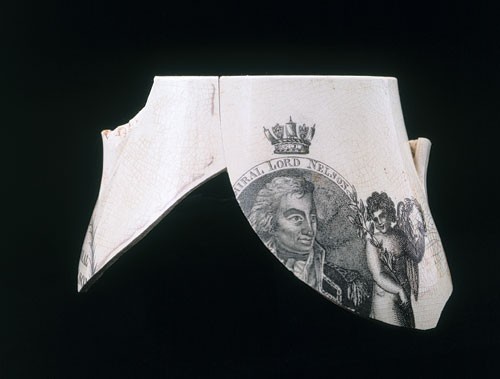
Mourning pitcher fragment, England, ca. 1805. Creamware. Found at the site of Arell’s Tavern, this pitcher has the words “ADMIRAL LORD NELSON” on a wreath cartouche below the spout. On one side is a portrait of Nelson flanked by cherubs. The missing portion shows a plan of the Battle of the Nile beneath the portrait. On the reverse are more cherubs within a wreath border. Nelson died tragically at Trafalgar as his troops defeated Napoleon.
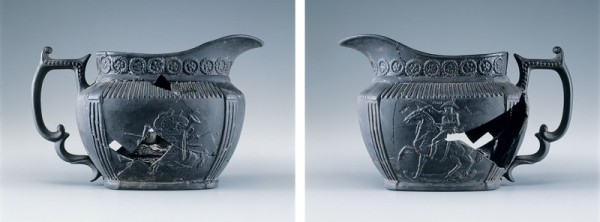
Creamer, England, ca. 1815. Basalt stoneware with glazed interior. L. 5 3/4". Tools of war appear on one side of this creamer; on the other side, inscribed above the figure of Wellington on horseback, are the words “VENI VIDI VICI.” This famous Latin phrase complements the creamer’s neoclassical form.
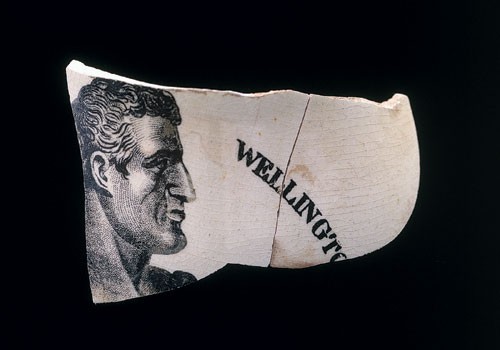
Pitcher fragment, England, ca. 1815. Creamware. This pitcher celebrates Wellington’s defeat of Napoleon at Waterloo, which ended twenty-three years of war between Britain and France.
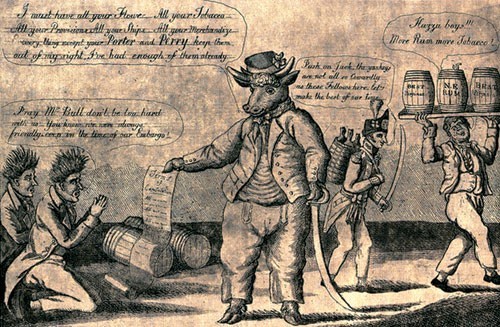
Johnny Bull and the Alexandrians, William Charles, 1814. Etching and aquatint. Sheet 9 3/4" x 13 1/2". (Courtesy, The Lyceum: Alexandria’s History Museum.) Alexandrians are shown cowering and pleading with Johnny Bull, a symbol for England. The cartoon ridicules Alexandria’s 1814 surrender to the British in the War of 1812. The Alexandrians plead: “Pray Mr. Bull don’t be too hard with us—You know we were always friendly, even in the time of our Embargo!” Their words suggest that British goods might have reached the port of Alexandria during the embargo years.
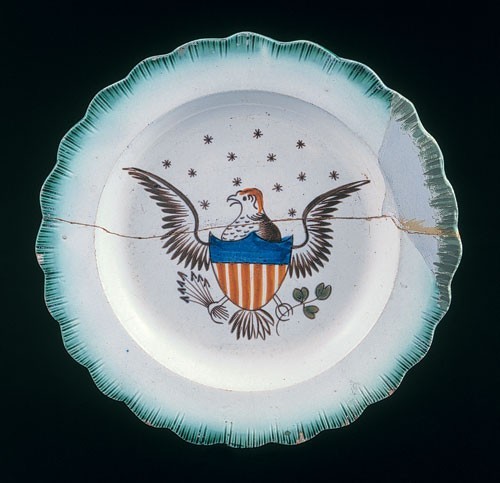
Plate, England, ca. 1815–1830. Pearlware. D. 7". The even scallop rim dates from ca. 1810–1835. Because of the limited palette of colors available for underglaze pearlware decoration, the shield is painted in orange and blue enamels. A set of these plates, marked with an impressed “B,” was found at Arell’s Tavern. An 8" blue shell-edged eagle plate was found at McKnight’s Tavern, whose location was marked by the shop’s sign, a spread eagle.

Pitcher fragment, England, ca. 1815. Creamware. This fragment, found at the site of McKnight’s Tavern, displays a merchant ship. The ship motif was common on creamware pitchers when the War of 1812 ended and trade was restored. It was often used in conjunction with commemorative patterns.

Pitcher fragment, England, ca. 1815. Creamware. These fragments from Arell’s Tavern show the upper portion of a pattern with the spread eagle motif perched atop the cannon. The female figure at right, representing Peace, is torching the tools of war. The figure at left, representing Plenty, holds a sheaf of wheat and a cornucopia. See fig. 27 for the decoration that would appear beneath the cannon. Additional fragments of this pitcher have the names Georgia, Massachusetts, and New Jersey on cartouches beneath the spout.

Pitcher fragment, England, ca. 1815. Creamware. This pitcher base was found in a privy associated with Gadsby’s Tavern. The pattern is similar to the example from Arell’s Tavern illustrated in fig. 26. The slogan “PEACE, PLENTY AND INDEPENDENCE” appears at the bottom. Another fragment of this pitcher, from beneath the spout, shows the American eagle carrying in its beak a ribbon with the motto “E PLURIBUS UNUM.”

Serving dish, attributed to James and Ralph Clews, Staffordshire, ca. 1818–1834. Pearlware L. 12 1/2". The America and Independence series depicts a variety of generic landscapes. This serving dish, recovered from the privy of Gadsby’s Tavern, shows an unidentified castle. The states—New Jersey, Pennsylvania, Maryland, New York, Delaware, Virginia, New Hampshire, Massachusetts, Rhode Island, Connecticut, North Carolina, South Carolina, Georgia, Vermont, and Kentucky—are named in the border. Two figures flank the scenic view, standing on plinths bearing the words “AMERICA AND / INDEPENDENCE.” A blindfolded figure labeled “justice” holds a portrait of Washington. A kneeling figure holds the Liberty Cap.
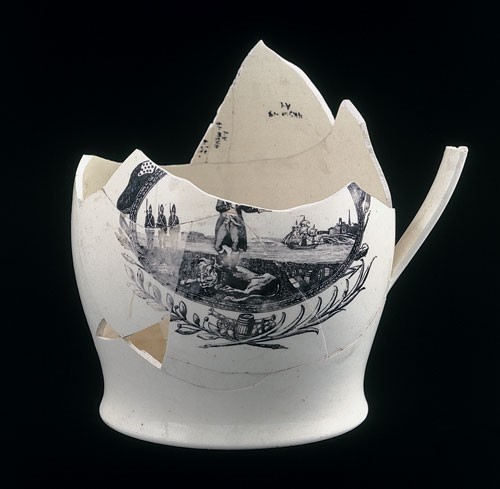
Pitcher fragment, England, ca. 1815. Creamware. This pitcher, found in a privy on a residential site at 414 King Street, commemorates the end of the War of 1812. The transfer print depicts a soldier standing on a lion—representing Britain—and gesturing toward a merchant ship under sail. American flags and weapons of war ornament the cartouche. A hunting scene is on the reverse.

Pitcher, England, ca. 1815. “Cameo jasper” refined stoneware. H. 6". This pitcher has applied relief decoration on a white stoneware body against a dark brown ground. The same pattern is also found on a blue or tan ground. The Great Seal is depicted on one side, and Miss Liberty on the other. Peace is represented by the caduceus and hands clasped in friendship, Plenty by the overflowing cornucopia. This pitcher celebrates the Treaty of Ghent, which was signed on Christmas Day 1814.

Pitcher, attributed to Enoch Wood, Staffordshire, ca. 1815. Creamware with buff-colored ground. H. 6 1/2". On one side appears Rembrandt Peale’s likeness of Captain Jacob Jones, and on the other that of General Zebulon Pike, portraits that were first published in the Analectic Magazine in 1813.
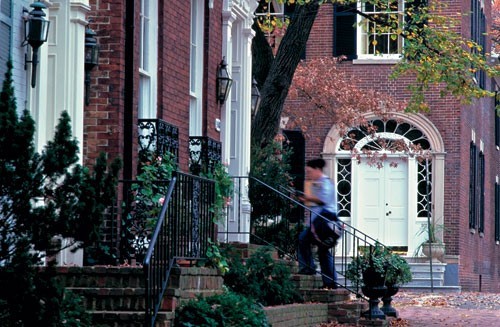
Lafayette House, 301 South St. Asaph Street, Alexandria, Virginia. In October 1824 Mrs. Thomas Lawrason lent her home to Lafayette during his visit to Alexandria. The house continues to be a private residence. (Courtesy, Office of Historic Alexandria; photo, Eric Kvalsvik.)
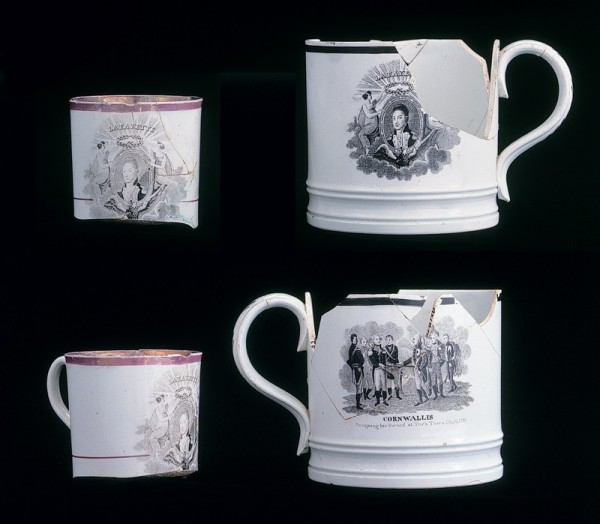
Coffee can and mug, England, ca. 1825. Pearlware. H. of coffee can 2 1/8"; H. of mug 3 1/8". The engraving Lafayette Crowned at Yorktown appears on both vessels. The engraving Cornwallis Resigning His Sword at York Town, Oct. 19, 1781, is on the reverse of the mug.

“MANUFACTURED / for Robt H·Miller / ALEXANDRIA. / D·C.” Importer’s mark, England, ca. 1830. Whiteware. Robert H. Miller was one of Alexandria’s most successful businessmen. In 1822 he opened a shop at 317 King Street, on the Market Square, having traveled to England to select the first stock of china and earthenware. Miller’s advertisements in the Alexandria Gazette state that the Lafayette/Cornwallis wares were “executed expressly for him, from a drawing sent out” (July 14, 1825), and that the Harrison campaign wares are from “designs sent out to the Potteries by himself” (September 19, 1840). In fact the designs are stock prints, but he may have selected the prints and vessel forms from a catalog. This mark is from the base of an unknown ceramic vessel that was discarded about 1830 at 418–422 S. Royal Street (44ax30), in the historic free black neighborhood known as Hayti.

Pitcher fragment, Enoch Wood and Sons, England, ca. 1828. Copper luster, red stoneware body, white slip interior. The Andrew Jackson, Hero of New Orleans motif is usually printed on a canary or blue band, but has also been seen on rust-colored bands. It is also found on a round form, although the slant-sided pitcher is more common. Ellouise Baker Larsen attributes the portrait to J. Wood, engraved by C. G. Childs (Philadelphia, 1828). Copper luster was made from about 1823 to 1845, so such pitchers were intended to celebrate Jackson’s presidential election, long after the Battle of New Orleans.
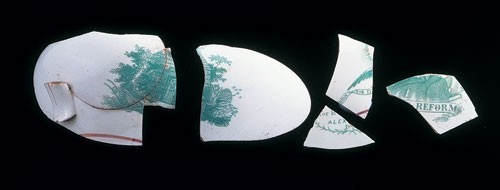
Pitcher sherds, England, 1840. Whiteware. These fragments of a small pitcher, made for Harrison’s “Log Cabin” campaign, were found in a well associated with a doctor’s office (among the other artifacts were tongue depressors, syringes, and eyeglasses). Only a few pieces were found, but they include a portion of the base with part of the mark “Manufactured for Robt H. Miller, Alexandria DC.” The log cabin depicted in the overglaze green transfer print has a sign on it that reads “TO LET IN 1841,” the year Harrison went to the White House. On the reverse is a portrait of Harrison and the motto “HARRISON AND REFORM.” Under the spout is an eagle holding a scroll bearing the motto “UNION FOR THE SAKE OF THE UNION.”
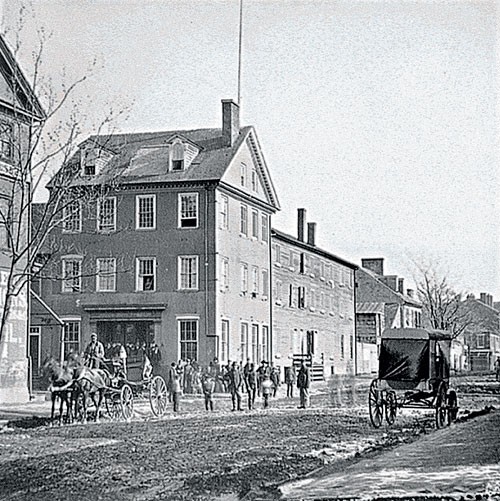
The Marshall House Hotel, King and Pitt Streets, during the Civil War. (Courtesy, Library of Congress, Prints and Photographs Division, lc-b8171-2294 dlc.)

Ellsworth pitcher, attributed to Millington, Astbury and Poulson, Trenton, New Jersey, 1861. Whiteware. H. 9". (Courtesy, The Lyceum: Alexandria’s History Museum.) This famous pitcher memorialized Colonel Elmer Ellsworth, the first Union martyr, who was killed in Alexandria on May 24, 1861. The design is based on a sketch by Corporal (formerly Private) Brownell. The molded design shows the figures of the slain Colonel Ellsworth on the left. Brownell, who avenged Ellsworth’s death by killing Jackson, is shown in the center, with “J. W. JACKSON THE TRAITOR” identified on the stairs. A Union eagle and Confederate serpent are depicted on the reverse, with a South Carolina palmetto supporting the early Confederate flag. The United States flag is supported by rifles.

Pitchers, Austria, ca. 1897–1908. Porcelain. Left: H. 6 1/2"; right: H. 3 1/2". (Courtesy, The Lyceum: Alexandria’s History Museum. Gift of Ken Turino.) They differ in shape, but these porcelain pitchers share the illustration of Christ Church, Alexandria, and the marks on the base (see fig. 40). Other scenes of churches and historic sites were made for retailers throughout the country. These pitchers were made for E. J. Miller and Co., at 119 King Street, Alexandria.

Detail of the mark used on the pitchers illustrated in fig. 39. Benjamin F. Hunt and Sons (B.F.H.S.) was a manufacturer and importer of porcelain from Austria at the turn of the century.
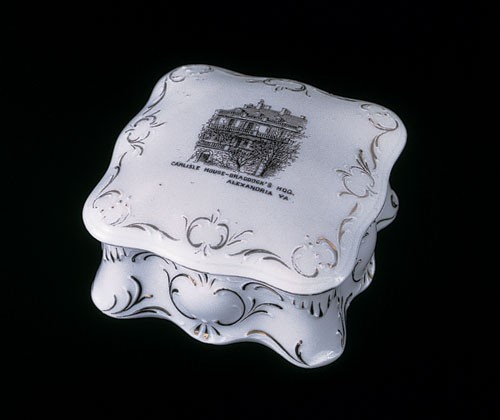
Lidded box, Austria, ca. 1897–1908. Porcelain. W. 4". (Courtesy, Alan Darby.) The box is inscribed “CARLISLE HOUSE—BRADDOCK’S HDQ., ALEXANDRIA VA,” and the markings on the bottom are the same as those illustrated in fig. 40.
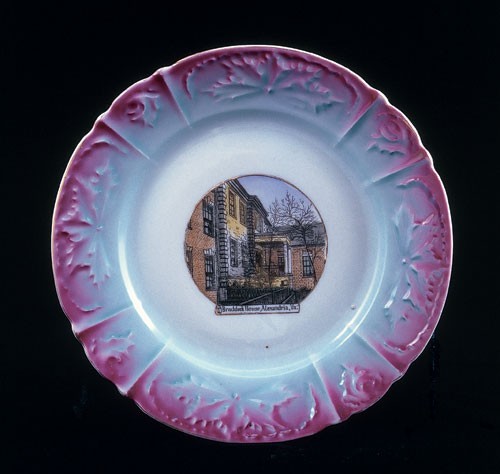
Plate, Germany, early twentieth century. Whiteware. D. 7 5/8". (Courtesy, The Lyceum: Alexandria’s History Museum. Bequest of William R. Adam.) General Braddock headquartered at John Carlyle’s house for three weeks in 1755, during the French and Indian War. This souvenir plate is illustrated with a postcard view of the Carlyle House. For many years the historic mansion was surrounded by a large hotel, which was at one time known as the Braddock House. C. E. Wheelock imported both postcards and china from Germany, and the company marketed plates with local postcard views directly to stores around the country.This plate was made for R. E. Knight in Alexandria. Knight’s Stationery, Toy and Souvenir store opened at 621–625 King Street in 1906. Souvenir china was imported from Germany from about 1890 to 1930.
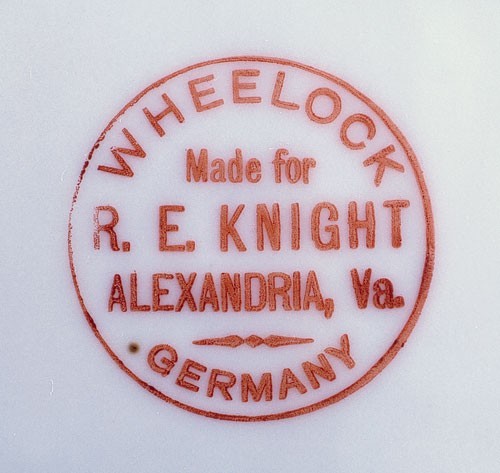
Detail of the mark used on the bottom of the plate illustrated in fig. 42.
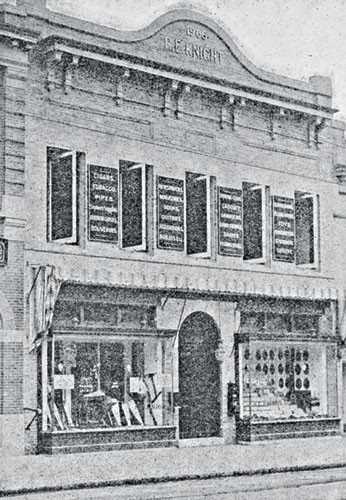
“R. E. Knight’s new Stationery, Toy and Souvenir stores,” 621–625 King Street, 1906. (Courtesy, Alexandria Archaeology Museum.) The store opened in 1906 and was illustrated in a 1907 souvenir booklet. Alexandria Archaeology’s offices were located in this building in the early 1980s.
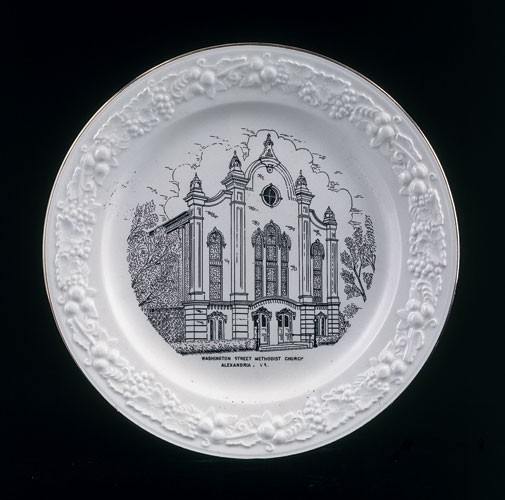
Plate, Homer Laughlin China Company, Newell, West Virginia, 1952. Whiteware. D. 9 3/4". (Courtesy, The Lyceum: Alexandria’s History Museum.) These plates likely were ordered for the centennial of the Washington Street Methodist Church, Alexandria, which was built in 1850–1851, as the numbers and letters in the green-printed maker’s mark date this plate to February 1952.

Detail of the mark used on the bottom of the plate illustrated in fig. 45.

Plate, J. H. Weatherby and Sons, Staffordshire, ca. 1990s. Whiteware. D. 9 7/8". (Courtesy, The Lyceum: Alexandria’s History Museum. Gift of Monta Lee Dakin.) This plate depicts the George Washington Masonic National Memorial in Alexandria, Virginia, which was built between 1922 and 1932. The memorial served as the home for Alexandria Lodge 22, of which George Washington was a member, serving as master from 1788 to 1789.
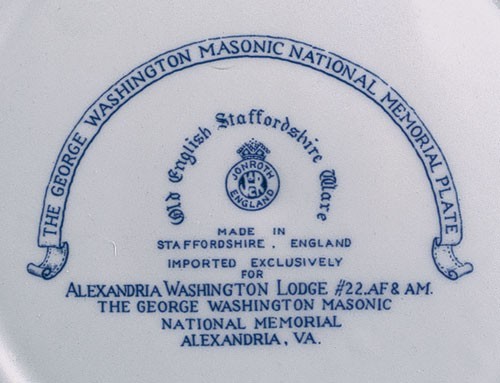
Detail of the mark used on the bottom of the plate illustrated in fig. 47.
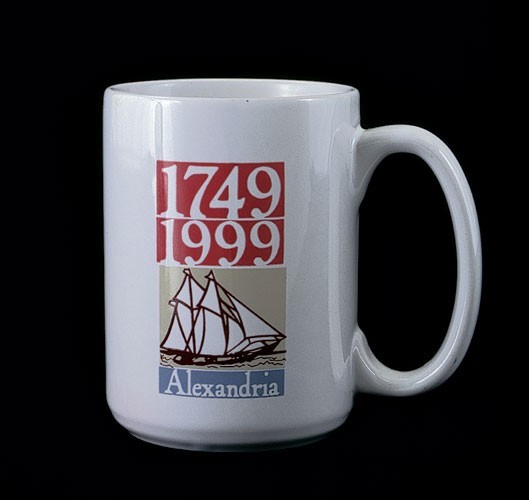
Mug, 1999. Whiteware. H. 3 1/4". This mug was commissioned by the City of Alexandria's 250th Birthday Commission to celebrate the 1999 anniversary of the city's founding. The logo shows a three-masted schooner under sail, honoring the city's maritime history.
“The people of Alexandria were always patriotic and public spirited,” wrote an Alexandrian on December 21, 1861, reminiscing about the city in the early nineteenth century.[1] Founded in 1749, Alexandria, Virginia, is certainly not among America’s oldest cities, but justifiably prides itself as being the hometown of George Washington (fig. 1) and Robert E. Lee. In the 1980s a billboard at the entrance to town declared it to be “America’s Most Historic City.” Events such as George Washington’s Birthnight Ball and Lafayette’s 1824 visit to Alexandria, both causes for great celebration, are re-created annually. These and other occasions of local and national significance were commemorated in ceramics that have been recovered from archaeological excavations at many of Alexandria’s private homes and taverns. Several of the city’s historic sites are also commemorated in ceramics, some of which are preserved in the collection of The Lyceum: Alexandria’s History Museum.
Commemorative wares first reached the American market during the colonial period and the early years of transfer printing. Only a few commemorative ceramics from the colonial period have been found in Alexandria, however, and these depict English heroes—Frederick the Great, Major-General James Wolfe, and Lord Rodney—and celebrate British alliances and victories in the Seven Years’ War, known in the United States as the French and Indian War.
After the Revolution, English potters recognized a fertile market in America and began to sell patriotic creamware there starting about 1800. Popular patterns included depictions of George Washington and other notable American personages. A pattern known as Britannia, or Pax, made to commemorate the Treaty of Amiens in 1802, was also popular. These wares celebrated not only the British victory against Napoleon but the end of America’s Quasi-War with France.
Fewer English wares reached American shores after the Embargo Act of 1807 and before the Treaty of Ghent, which ended the War of 1812 on Christmas Day 1814. After the resumption of trade, English-made American historical wares reached Alexandria and other ports in great quantities. Shell-edged plates depicted the American eagle (adopted as the Great Seal of the United States in 1782),[2] and various commemorative wares celebrated peace and such American heroes of the War of 1812 as Zebulon Pike and Jacob Jones. Lafayette and Cornwallis were honored after Lafayette’s celebrated visit to America, and Presidents Andrew Jackson and William Henry Harrison were portrayed in ceramics in 1829 and 1841, respectively.
In the nineteenth century ceramics celebrated America itself, portraying views of historic and scenic sites. Transfer-printed ceramics, imported from England, depicting scenes from Washington, D.C., to Boston have been found in excavations in Alexandria. Although not found archaeologically, scenes of Alexandria were depicted on ceramics at the turn of the twentieth century; two of these sites, Christ Church and Braddock House (known today as the Carlyle House), have national significance. Later in the twentieth century, popular local properties, such as the Washington Street Methodist Church and the George Washington Masonic National Memorial, commissioned their own commemorative wares.
Alexandria and the French and Indian War
The French and Indian War (1754–1763) resulted in France losing most of its North American territories to England. British Major General Edward Braddock, commander-in-chief of all British forces in North America, arrived in Alexandria with about 1,600 British troops. For three weeks in 1755, he was headquartered at the house of John Carlyle (fig. 2), a prominent merchant and one of the founding fathers of Alexandria. Braddock appointed Carlyle, who had just resigned as overseer of the town, to provision the British forces.[3]
During Braddock’s visit, a congress of colonial governors met with military leaders at Carlyle’s house to plan their strategy against the French. In a letter to William Fairfax dated April 23, 1755, George Washington wrote: “Alexandria has been honoured with 5 Governours in Consultation—a favorable presage I hope, not only of the success of this Expedition, but of the future greatness of this town for surely, such a meeting must have been occasioned by the Commodious, and pleasant situation of the place.”[4] John Carlyle, however, was less than pleased with his illustrious visitors. On August 15, 1755, he wrote to his brother George:
They differed, us & them, and . . . came In so prejudiced against us, our Country & etc. that they used us Like an Enemy Country: took everything they wanted & paid Nothing, or Very little for it. . . . The General & his Aid de Camps, Secretary, & Servants Lodged with Me. He took everything he wanted, abused my home & furniture, and made me little or no satisfaction—tho Expressed a Great deal of Friendship for me & Gave me a Commission as Keeper of the Kings Storehouses, which he assured Me Should be worth £100 per Anno to me, and paid me £30 for the use of my house for a Month. . . .
Carlyle characterized Braddock as “a man (if I am a judge) of Week [sic] understanding, Positive, & Very Indolent; Slave to his Passions, Women & Wine... Tho’ a brave man.” Nevertheless, he wrote of the gathering as “the Greatest Congress held at My home ever known on This Continent . . . .”[5]
The war spread from America to Europe in 1756. Frederick the Great of Prussia allied with Britain against Maria Theresa of Austria, who was allied with the French. The British gave active aid to Prussia beginning in 1758, and their battles against French forces were commemorated with white salt-glazed stoneware plates marked “Success to the King of Prussia” (fig. 3).[6] In America, Braddock led a band of British and colonial soldiers, among them George Washington, against the French at Fort Duquesne (located in what is now Pittsburgh, Pennsylvania). He died of battle injuries, and Washington led the surviving troops to safety.
Braddock’s visit, the involvement of George Washington, and the participation of local troops gave immediacy to the French and Indian War for Alexandrians, and this was reflected in everything from wares to street names. In addition to a King of Prussia plate, archaeologists found later wares, one of which depicts General Wolfe, who led British forces in the capture of the city of Quebec from the French. The battle on the Plains of Abraham, on September 13, 1759, lasted less than an hour but is considered the decisive battle of the French and Indian War. Both Wolfe and his rival, the French marquis de Montcalm, died from battle wounds. A letter written five days later by Rear Admiral Charles Holmes described the battle:
About Ten, [Montcalm] marched in order of Battle & attacked us on the Plains of Abraham. His Disposition was excellent, & his Army advanced in very good order. Wolfe was entirely prepared; & overjoyed at the unexpected Resolution of the Enemy.
They fired twice before he made any return; Then commenced the Battle which hardly lasted a quarter of an Hour . . . Gen’r Wolfe fell early in the action, & only lived long enough to know that his Troops were victorious; On learning of which, he said—“Since I have conquered I dye satisfied.”[7]
The Death of Wolfe, a well-known neoclassical painting of 1770 by Benjamin West, is the source of an engraving on a English creamware pitcher fragment found in Alexandria (fig. 4) as well as on similar wares made by other English potteries. The Alexandria pitcher differs from a Wedgwood pitcher illustrated by Ellouise Baker Larsen in several ways.[8] The most significant involves a standing figure to the left of the group surrounding the dying general. This figure is a reverse image of an officer with clasped hands who stands to the right in the original painting.[9]
A later ware found by archaeologists in Alexandria depicts Lord Rodney, who by capturing Martinique from the French became another hero of the French and Indian War. However, in the American Revolution Rodney became an enemy of the colonists, defeating the Spanish fleet off Cape St. Vincent and then the French fleet (both countries were American allies) at the Battle of the Saints. After his successes for the British, Rodney was made a baron in 1782, and his likeness appeared on pub signs as well as commemorative pottery.[10]
Rodney’s exploits during the Revolution were certainly known to Alexandrians. An extract of a letter from Jamaica, dated March 17, 1784, was reprinted in the Alexandria Gazette: “A military gentleman, sailing here from Antigua, called at St. Eustatius. There he found the inhabitants amusing themselves by burning Lord Rodney and General Vaughan in effigy, the island having been returned to the Dutch the day before.”[11] A fragment of a tankard depicting Lord Rodney (fig. 5) that was found on an archaeological site in Alexandria was made around the time that this letter was published. Its presence may indicate loyalist sentiments lurking in an Alexandria household, or it may simply commemorate a well-known figure of the day.
Alexandria Mourns George Washington
Alexandria has always taken great pride in being the hometown of George Washington. A replica of his town house, which was demolished in 1857, stands at 508 Cameron Street (fig. 6), and his family pew at Christ Church (fig. 7) still bears his name.[12] Washington frequented many of Alexandria’s taverns for both business and pleasure. He dined at Lomax’s Tavern with Lafayette in 1784 and celebrated the ratification of the Constitution at Wise’s Tavern in 1788. At Gadsby’s Tavern, also known as the City Hotel, he danced at his own Birthnight Balls, which are still celebrated today (fig. 8).
The importance of Washington’s birthday celebrations in the 1830s was recounted in the reminiscences of an “Old Bachelor” on his return to Alexandria thirty years later.
The great day with us, in old Alexandria, was Washington’s Birth Day—the 22nd of February—the anniversary of the birth of our fathers’ friend and neighbor, as well as the Father of his Country. . . . There was a more general public, united celebration of that day, than there was even of the 4th of July . . . . Then the military paraded and kept together. A long procession was formed, consisting of the Town Authorities, the reverend clergy, the civic associations—and there were several, then of the highest respectability as to character and numbers—the Fire Companies—the Free School children (the latter all neatly dressed, headed by their teachers—the most interesting part of the pageant)—the volunteer companies with their bands of music—followed by a long line of citizens who made it a rule always to unite in the ceremonies of the occasion—and escorted the Reader of the Farewell Address and the Orator of the Day, to some one of the Churches, where the exercises took place. There was always a fine Ode sung—an appropriate prayer made—and then succeeded the reading, and the speech. . . . Flags were hoisted, cannon fired, and huzzas shouted in every direction, throughout the day. . . .
On the night of the 22nd, there was the “Birth Night Ball.” . . . Washington, himself, more than once attended the balls—and there is, or was, in the Museum, an autograph letter of his, framed, sending his apology, on one occasion, for not being able to come into town to visit his friends, at this, the most delightful of their social meetings. . . . At 12 o’clock precisely, supper was announced—and these suppers were equal to any of the feasts ever prepared at the old City Hotel, then and since famous for the excellence and taste of its entertainments.[13]
Drs. James Craik and Elisha Cullen Dick, who attended Washington on his deathbed, were both Alexandrians. Their account of Washington’s final illness, which was published in the Virginia Herald, ended with these words: “During the short period of his illness, he economized his time, in the arrangement of such few concerns as required his attention, with the utmost serenity; and anticipated his approaching dissolution with every demonstration of that equanimity for which his whole life has been so uniformly and singularly conspicuous.”[14]
The bells of the Old Presbyterian Meeting House tolled for four days and nights after Washington’s death, and a memorial service was held there on December 29, 1799.[15] The news of Washington’s death and its effect on Alexandrians appeared in the Alexandria Times and District of Columbia Advertiser:
Washington in Glory—America in Tears
The effect of the sudden news of his death upon the inhabitants of Alexandria can better be conceived than expressed. At first a general disorder, wildness, and consternation pervaded the town. The tale appeared as an illusory dream, as the raving of a sickly imagination. But these impressions soon gave place to sensations of the most poignant sorrow and extreme regret. On Monday and Wednesday the stores were all closed and all business suspended, as if each family had lost its father. From the time of his death to the time of his interment the bells continued to toll, the shipping in the harbor wore their colors half mast high, and every public expression of grief was observed. On Wednesday, the inhabitants of the town, the county, and the adjacent parts of Maryland proceeded to Mount Vernon to perform the last offices to the body of their illustrious neighbor. All the military within a considerable distance and three Masonic lodges were present. The concourse of people was immense. Till the time of interment the corpse was placed on the portico fronting the river, that every citizen might have an opportunity of taking a last farewell of the departed benefactor.[16]
Similar to the title of that article, the words “HE IN GLORY · AMERICA IN TEARS” were printed on English creamware pitchers commemorating Washington’s death. One of them, a mourning pitcher recovered from excavations in a well behind 416–418 King Street, Alexandria (fig. 9), has been attributed to the Herculaneum Pottery in Liverpool, England.[17] A tanner, Robert William Kirk, owned a store and dwelling on this property from the time of Washington’s death until 1804, when it was sold to Jacob Fortney, who owned a stable and blacksmith shop.
Commemorative wares were again issued at special anniversaries of Washington and the nation. A surviving fragment of a Rockingham teapot or pitcher depicting Washington’s bust was discovered (fig. 10), along with other artifacts from the 1840s and 1850s, during excavations in Alexandria. The teapot or pitcher probably was made in 1849 to commemorate the fiftieth anniversary of Washington’s death, reflecting his continued importance to Americans (and Alexandrians in particular, who hold the largest parade in the country in honor of Washington’s birthday). In 1875, in time for America’s centennial and just after the seventy-fifth anniversary of Washington’s death, Wedgwood made a bust of Washington based on the famous sculpture by the French sculptor Jean-Antoine Houdon (fig. 11).[18]
Alexandria and America’s Quasi-War with France
The household of Samuel Snowden, editor of the Alexandria Gazette, discarded a large punch bowl with a transfer-printed pattern known as Britannia or Pax (fig. 12). Archaeological excavations also show that a neighboring house around the corner on the 400 block of King Street had a set of teacups and saucers in the same pattern (fig. 13), as did McKnight’s Tavern across the street (fig. 14). The pattern celebrates the Treaty of Amiens in 1802 and symbolizes Britain’s victory over France, although Americans may have purchased these wares to celebrate their country’s own victories over the French and Napoleon.[19]
The Britannia wares were first manufactured in 1802 and may have reached America any time before the Embargo of 1807, which was instituted by President Thomas Jefferson against the French and English for interfering with American shipping. Pearlware vessels such as these, in which the outline of the design was transfer printed in brown and then painted in polychrome colors, are sometimes known as Salopian ware (i.e., from Shropshire), although the wares were made by a number of English factories in the early part of the nineteenth century. They were commonly made for the American market and are found more often in this country than in England.[20]
A variety of wares depicting the American eagle and patriotic themes also date from these years, before the 1807 embargo. The eagle from the Great Seal of the United States is featured on two pitchers made in the style of the Castleford Pottery, with molded borders separating panels with molded relief patterns. The Castleford Pottery is not known to have made wares with American symbols, but their style of pottery was copied by several other manufacturers, and attributions can sometimes be made based on the molded relief patterns used as borders. A Castleford-style white feldspathic stoneware pitcher (fig. 15) has been attributed to Sowter and Company,[21] and a pearlware pitcher (fig. 16) has been attributed to the Leeds Pottery based on its similarity to a feldspathic stoneware sucrier commemorating Admiral Lord Nelson and General Howe.[22] The eagle emblem has also been found on a soft-paste porcelain saucer (fig. 17) and a bone china coffee can (fig. 18), both manufactured in England.[23] A patriotic pitcher attributed to the Herculaneum Pottery shows a reproduction of the print An Emblem of America (fig. 19), first published in 1799. It depicts a central female figure, draped in classical garb and holding an American flag, flanked by Indians and portrait medallions of some of America’s best-known figures, including Christopher Columbus, Americus, Sir Walter Raleigh, Benjamin Franklin, George Washington, and John Adams.[24]
In 1781 America’s French allies under Jean-Baptiste-Donatien de Vimeur, comte de Rochambeau, encamped in Alexandria, near Four Mile Run, on their way to Yorktown and the defeat of the British. “The most elegant and handsome young ladies of the neighborhood danced with the (French) officers on the turf, in the middle of the camp, to the sound of military music.”[25] America’s alliance with the French had been instrumental in winning American independence, and Americans were supportive of the goals and ideals of the French Revolution through the storming of the Bastille in 1789 and the beginnings of the French Republic in 1792. A few months after Louis XVI was deposed, however, the Reign of Terror began, and thousands were executed within the year, events that horrified Americans. As French power spread through Europe, Americans became mistrustful of France’s growing empire and concerned with French expansion in Louisiana. In 1794 Congress declared neutrality in the Anglo-French conflict, a move the French believed violated a 1778 treaty that required America to help protect French colonies in the West Indies against the British. In retaliation, French privateers attacked American merchant ships, leading to an undeclared naval war that became known as the Quasi-War.[26]
The port of Alexandria played a role in the attack of the fledgling U.S. Navy against privateers in the West Indies. In May 1798 Lieutenant James Triplett was sent from Baltimore to Alexandria to “engage as many Seamen and Marines as he can find disposed to enter on board the Frigate Constellation.” In the next year at least three privateers were built at Alexandria shipyards, each carrying twenty-two guns and fifty-four crewmen.[27]
By 1800 many of Alexandria’s wharves had been converted for construction of ships for the Quasi-War. Even the County Wharf, which had been in disrepair, was refurbished for shipbuilding. The French seized at least twenty of the Alexandria-built ships in the West Indies.[28] In April 1799 the secretary of the navy authorized a brig with eighteen guns to be built in Alexandria. However, the order was rescinded three weeks later, amid concerns about how quickly the ship could be built. The navy instead ordered 40,000 pounds of ships’ bread from the Jamieson bakery in Alexandria.
Trade with Europe and the West Indies was immensely important for Alexandria, one of the largest ports in the United States at the beginning of the nineteenth century, and the town had suffered as a result of the Anglo-French and American-French hostilities. The end of the Quasi-War with France aroused patriotic fervor in Alexandria—and, indeed, the nation—and these commemorative wares were one manifestation of the sentiment. Alexandrians were celebrating not only the Treaty of Amiens and the new, albeit short-lived, peace in Europe but also the end of American-French hostilities in the West Indies and the Louisiana Purchase in 1803, which ended French occupation in North America and nearly doubled the size of the United States.
Two great English heroes of the long Napoleonic Wars are portrayed on ceramics found in Alexandria: Vice Admiral Horatio Nelson on a pitcher from Arell’s Tavern (fig. 20), and the duke of Wellington on a basalt stoneware creamer and a creamware pitcher from homes nearby (figs. 21, 22). Although Nelson died tragically at Trafalgar on October 21, 1805, his troops were victorious over Napoleon. After this naval defeat France was no longer a threat to Britain, and Nelson, a greatly loved British hero, was commemorated with a large assortment of souvenirs. A decade later, in June 1815, the duke of Wellington defeated Napoleon on land at the Battle of Waterloo, near Brussels. The Wellington ceramics commemorate this battle, which ended twenty-three years of war between Britain and France and exiled Napoleon to St. Helena. Wellington became a hero throughout Europe. He played a role in the War of 1812, urging Britain to accept the Treaty of Ghent, which brought to a close the war with the United States, and went on to become Britain’s prime minister in 1828.
Alexandria and the War of 1812
The Embargo of 1807, placed by Jefferson on commercial trade with England, was in response to a British decree that limited American trade and required that duty be paid at British ports. Ultimately leading to the War of 1812, the embargo greatly affected Staffordshire potteries, which had enjoyed a lucrative trade with America. From 1795 to 1800 approximately ten million pieces of Staffordshire pottery were imported annually by American merchants, and although trade did not cease during the embargo, production at the potteries decreased by 60 percent and unemployment was high.[29]
After the War of 1812 began, Alexandria merchants again supplied the navy with ships’ biscuits and other supplies, as they had during the Quasi-War with France. On August 23, 1814, British troops set fire to Washington. A British soldier wrote:
[T]his was a night of dismay to the inhabitants of Washington. They were taken completely by surprise. . . . The first impulse of course tempted them to fly, and the streets were in consequence crowded with soldiers and senators, men, women, and children, horses, carriages, and carts loaded with household furniture, all hastening toward a wooden bridge which crosses the Potomac. . . . Of the senate-house, the President’s palace, the barracks, the dockyard, etc., nothing could be seen, except heaps of smoking ruins; and even the bridge, a noble structure upward of a mile in length, was almost wholly demolished.[30]
Threatened with an invasion as well, and with insufficient forces to defend its city, Alexandria’s Common Council surrendered to the British without resistance. British forces occupied the city for five days, from August 29 through September 2, and although the British did not burn the city, they looted its stores and warehouses. According to the terms of capitulation, “The town of Alexandria, with the exception of public works, shall not be destroyed, unless hostilities are commenced on the part of the Americans; nor shall the inhabitants be molested in any manner whatever, or their dwelling-houses entered, if the following articles are complied with. . . .”[31] Alexandria’s mayor wrote: “It is impossible that men could behave better than the Britissh [sic] behaved while the town was in their power, not a single inhabitant was insulted or injured by them in their person or houses.”[32] A prominent Alexandrian Quaker, the apothecary Edward Stabler, wrote: “Their conduct was respectful and decorous; and instead of that exultation and triumph which expands the heart of a soldier when he encounters and overcomes a force like his own, these were evidently dejected and adverse to what they were doing.”[33]
Alexandria was sharply criticized and ridiculed for its surrender, however. A political cartoon published in Philadelphia in 1814 (fig. 23) shows Alexandrians cowering and pleading with Johnny Bull, symbolic of England.[34] On August 31, 1814, an editorial in the Richmond Enquirer stated, “In what terms can we express our indignation against the conduct of the citizens of Alexandria? Thanks be to the Almighty God: that this degraded town no longer forms a part of the state of Virginia!”[35]
When the Treaty of Ghent was signed, on Christmas Day 1814, Alexandria had much to celebrate. With the end of the War of 1812, America’s continuing independence was assured and the seas were open to trade with all nations. A number of ceramics celebrating the end of the war and honoring its heroes have been found at archaeological excavations in Alexandria, many at tavern sites.
Arell’s Tavern, in particular, used many patriotic pieces, including a set of small shell-edged plates with an “even scallop” pattern and depicting the American eagle (fig. 24), a motif that appears on wares made before the Embargo of 1807 (see, for example, figs. 15-18) but was commonly used following the end of the War of 1812.[36] These dishes were popular among the lower and middle classes from about 1815 to 1830[37] and therefore were appropriate for Arell’s, a working-class tavern. Another blue shell-edged eagle plate was found at McKnight’s Tavern, which was known by its sign of the spread eagle.
Merchant ships were also a common motif on creamware pitchers, celebrating the resumption of trade following the War of 1812 and the prosperity it was expected to bring. McKnight’s Tavern, for example, had a creamware pitcher showing a merchant ship under sail (fig. 25), a motif often used on the reverse of other commemorative patterns.
Many variations of the popular print Peace, Plenty and Independence appeared on creamware and pearlware pitchers made for the American market by the Staffordshire potters Enoch Wood and Sons, Herculaneum, and others. The print depicts the spread eagle perched atop a cannon, beneath which is a circle with the slogan “Peace, Plenty and Independence.” There is a female figure at right, Peace, who torches the tools of war; a figure at left, Plenty, holds a sheaf of wheat and a cornucopia. Creamware pitchers were found at Arell’s Tavern and Gadsby’s Tavern with representations of Peace, Plenty, and Independence. In cartouches under the spout of the pitcher from Arell’s (fig. 26) appear the names of Georgia, Massachusetts, and New Jersey. The example from Gadsby’s (fig. 27), which was produced at another pottery, has a version of the Great Seal under the spout with the eagle carrying a ribbon bearing the motto “E PLURIBUS UNUM.”
Gadsby’s Tavern also had a pearlware transfer-printed serving dish, attributed to James and Ralph Clews, circa 1818–1834, which was part of a series known as America and Independence (fig. 28). Despite the generic English landscapes, the America and Independence series has strong American patriotic content.
From nearby residential sites, archaeologists recovered pitchers with representations of Virtue and Valour and Peace and Plenty, and others honoring the war heroes General Zebulon Pike and Captain Jacob Jones. An Alexandria creamware pitcher (fig. 29) found in a privy on a residential site depicts a soldier standing on a lion (Britain) and gesturing toward a merchant ship under sail. American flags and weapons of war ornament the cartouche. Many different versions of this print appear on pitchers, bowls, and plates, and each usually includes the words “By Virtue and Valour We Have Freed Our Country, Extended Our Commerce, and Laid the Foundation of a Great Empire.”[38]
On the stoneware Peace and Plenty pitcher (fig. 30), hands clasped in friendship and the caduceus represent Peace, and the overflowing cornucopia represents Plenty.[39] The American Eagle is depicted on one side, and Miss Liberty on the other. This depiction of Liberty is known as the “capped bust to right” found on gold coins from about 1795 to 1806.[40] The same pattern is also found on a blue or tan ground.[41] This pitcher celebrates the Treaty of Ghent, which was signed on December 25, 1814, but similar pitchers and mugs were made to celebrate the Battle of Waterloo, which took place six months later. On these pieces the words “Peace and Plenty” were replaced with “La Belle Aliance,” a reference to the meeting between the duke of Wellington and Marshal Blücher at the inn of that name. On the sides are busts of Wellington, or Wellington and Blücher, replacing the Eagle and Liberty.[42]
Rembrandt Peale’s portraits Jones of the Macedonian and General Pike, first published in 1813,[43] adorn a creamware pitcher with a buff-colored ground attributed to Enoch Wood (fig. 31). Jacob Jones was appointed midshipman in 1799 and served during the Quasi-War with France. In the War of 1812, as commander of the Wasp he captured the British brig Dolphin and defeated the British warship Frolic. After he was commissioned captain, in 1813, Jones commanded the Macedonian, which in 1815, after the war, he commanded against the Barbary powers in Algiers.[44] General Zebulon Pike was an explorer, best known for his discovery of Pike’s Peak in Colorado. Pike led expeditions on behalf of the U.S. Army to explore the headwaters of the Mississippi River and the southwestern borders of the Louisiana Purchase. A brigadier general in the War of 1812, Pike commanded American troops at the Battle of York (now Toronto) on April 27, 1813. As his troops entered the fort, the British blew up a stone powder magazine. The rain of stone and timber killed Pike and many of his men. Still, the Americans captured the fort and began to take control of the Great Lakes.[45]
“A La Fayette this, and a La Fayette that”
Lafayette served on George Washington’s staff and helped to defeat Cornwallis at Yorktown. Cornwallis surrendered to American and French allies under Washington in what is considered to be the definitive battle of the Revolution. Lafayette returned to France and the French Revolution but was forced to flee during the Napoleonic era; he returned to public life in France after Napoleon’s defeat.
General Lafayette’s triumphal tour of America in 1824, after a forty-year absence, was celebrated throughout the country. As the last surviving general of the Revolutionary War, Lafayette was invited by President James Monroe to be “the Nation’s Guest.” He attended parades, ceremonies, and receptions in all twenty-four states. Lafayette visited Alexandria five times,[46] but his most important visit began on October 19, 1824, when a grand reception and celebration were held in his honor.
[T]he reception and welcome of Lafayette . . . in Alexandria were pronounced by John Q. Adams as equaling any, in any part of the country, in design and execution. . . . Lafayette was much interested in the many associations connected with Washington surrounding Alexandria, and spoke of it as Washington’s town, which he well remembered.[47]
For almost a month Lafayette resided at 301 South St. Asaph Street, in an imposing brick house lent to him by Mrs. Thomas Lawrason (fig. 32).[48]Another contemporary, the well-known Quaker educator Benjamin Hallowell, wrote in his diary:
Washington street in Alexandria is one hundred feet wide, each sidewalk being eighteen feet. There were three spans of arch erected in honor of La Fayette across it, just north of King street, two of eighteen feet span over the sidewalks, and the central one sixty-four feet span. They made a very handsome appearance. Appropriate mottos were on each side of each arch. I remember the two that were on the central arch. On the side of his approach was, “Welcome La Fayette! A nations’s gratitude thy due!” On the other was an extract from a speech he had made in the Paris Tribune, “For a nation to be free, it is sufficient that she wills it.”
Colonel Mountford, keeper of the Alexandria Museum, had fastened one of his live eagles on the crown of the arch, with its head in the direction of the approach of the procession, and he and others said that just as the General was passing under the arch, the eagle rose, spread out his wings to their full extent, then gracefully folding them, resumed his former position.[49]
Another account of the procession describes “a fully rigged ship hung beneath the central span of the arch and the whole . . . decorated with cedar, laurel and oak, set off by a liberty cap.”[50] Regarding Colonel Mountford and the eagle, the “Old Bachelor” adds:
His happiest and busiest days were about the time of the reception of Lafayette here, when he was employed at the arch on Washington street, for which he procured the “live eagle,” which afterwards gave him so much trouble, but which he would never give up or suffer to go into other hands, but kept it “flourishing” as long as he lived.[51]
Numerous Lafayette souvenirs were available throughout the country in anticipation of Lafayette’s visit, and they continued to be sold for more than a year. In September 1824 the Alexandria Gazette advertised “La Fayette badges” for sale at J. H. Runnell’s hat and fancy store on King Street.[52] On July 14, 1825, another King Street merchant, Robert H. Miller, offered “China cups and saucers, Tea plates & snuff boxes, Imitation China pitchers, Mugs and bowls, Lustre pitchers of all sizes, mugs and cans With a drawing of La Fayette & the surrender of Cornwallis. Executed expressly for him, from a drawing sent out.”[53] These proved to be so popular that in March 1826 Miller offered “a further supply of Lafayette Ware” along with “tea-sets gold edge and view of Mount Vernon.”[54] A prominent member of Alexandria’s Quaker community, as well as the son and grandson of successful merchants, Miller was one of Alexandria’s foremost businessmen and most influential citizens.[55]
Archaeologists recovered a Lafayette and Cornwallis pearlware mug (fig. 33, right) from a well in which it had been discarded by the family of Ann Buckland, who lived at 104 South St. Asaph Street from 1810 to 1834.[56] Several examples of ceramics marked “Manufactured for Robt H. Miller/ Alexandria D·C” have been found in Alexandria (see figs. 34, 36), and although this mug is unmarked, it fits the description in Miller’s 1825 advertisement. The mug is adorned with an engraving, Lafayette Crowned at Yorktown, depicting two angels holding the wreath of laurels with which Lafayette was crowned at Yorktown in 1824. On the reverse is Cornwallis Resigning His Sword at York Town, Oct. 19, 1781, which originally illustrated the epic patriotic poem “The Columbiad,” published by Joel Barlow in 1807.[57] This print was also used on earlier creamware.[58]
A small coffee can with a similar image of Lafayette Crowned at Yorktown was found in a well associated with Gadsby’s Tavern, one of the places at which Lafayette is known to have dined. The coffee can is of pearlware with a black overglaze transfer print and a purple luster rim (fig. 33, left).
Benjamin Hallowell wrote about the ubiquitous Lafayette souvenirs in a letter to his uncle, as well as in his diary. Hallowell and his wife were returning from their wedding, which had taken place the day before Lafayette’s visit to Alexandria:
Each lover of liberty surely must get
Something in honor of La Fayette.
There’s a La Fayette watch-chain, a La Fayette hat,
A La Fayette this, and a La Fayette that.
But I wanted something as lasting as life,
And took to myself a La Fayette wife.[59]
Alexandria and Presidential Campaigns
Two American heroes of the War of 1812, Andrew Jackson and William Henry Harrison, went on to become president of the United States—in 1829 and 1841, respectively—and the Alexandria merchant Robert H. Miller imported campaign souvenirs for both of their elections.
ANDREW JACKSON
On January 3, 1829, the Alexandria Gazette advertised: “Robert H. Miller has just received per Pioneer, direct from Liverpool, a further supply of EARTHENWARE & CHINA; among which are . . . plain and lustred pitchers, mugs, twiflers and muffins with an excellent portrait of Gen. JACKSON....” One such “lustred” pitcher, which had been made for Jackson’s presidential election (fig. 35), was found in a privy at 522–524 King Street.[60] This property was occupied by a series of short-term renters, one of whom was Lewis McKenzie, a grocer and Union sympathizer who became Alexandria’s mayor during the Civil War.
Andrew Jackson became the seventh president of the United States on March 4, 1829, after an unsuccessful attempt four years earlier. Born on the frontier and known as “Old Hickory,” he was hailed as a symbol of the common man. He was nationally known for leading American troops to victory in the Battle of New Orleans, a battle fought on January 8, 1815, two weeks after the Treaty of Ghent was signed. In the days of slow communication, word that the treaty had been signed in Europe did not reach troops in America, and the Battle of New Orleans was the decisive battle ending the war. The American public heard about the battle before it heard about the treaty, and so hailed Jackson for his role in ending the war. His popularity as a military hero helped him to gain the presidency.
In 1833, during his second term, Jackson was aboard the presidential steamer in Alexandria’s harbor when Lieutenant Robert Beverly Randolph, a naval officer who had been dismissed for misconduct, went on board and assaulted Jackson, striking him in the face (or, by another account, seizing his nose). Randolph was held and punched in the ribs, but in the confusion his friends helped him to escape and provided him with a horse. One of them was said to be the son-in-law of John Gadsby, former owner of Gadsby’s Tavern. Randolph was not captured for several months and the charges eventually were dismissed.[61]
WILLIAM HENRY HARRISON
Harrison, like Jackson, was a nationally known military hero. He served in a campaign against the Indians, which opened up the Ohio frontier. He served as secretary of the Northwest Territory and, later, as governor of the Indiana Territory. Harrison worked to obtain Indian lands and met opposition from Tecumseh. Harrison is remembered for fighting Tecumseh and the Indian confederacy at the Battle of Tippecanoe in 1811. In the War of 1812 he defeated British and Indian forces near Lake Erie. His old nemesis Tecumseh was killed in this battle, which ended serious Indian resistance in the Northwest.
Harrison was cast as the common man, as was Jackson, although he was a candidate of the conservative Whig Party, the opponents of Jacksonian democracy. Harrison was the son of an aristocratic Virginia planter, but his military and political career in the Northwest enabled him to be presented as a simple frontiersman, in contrast to the aristocratic Martin Van Buren. With the “Log Cabin” campaign and the slogan “Tippecanoe and Tyler Too,” Harrison was the first presidential candidate to conduct a public campaign. Harrison, said to have caught cold at his inauguration, developed pneumonia and died after only one month in office, ending the hopes of the Whig Party.[62]
Whereas the ceramic pitchers commemorating Andrew Jackson were imported from England by R. H. Miller after Jackson was elected president, the Harrison wares were souvenirs distributed as part of his election campaign. An advertisement published in the Alexandria Gazette on September 19, 1840, read in part: “N.B.— By an early arrival, R.H.M. expects supplies of ware with Harrison and Log Cabin engravings, from designs sent out to the Potteries by himself. Whig merchants will be supplied upon the ‘Credit System’ at reasonable prices, in time to celebrate the approaching triumph of correct principles.”
Fragments of a Harrison pitcher (fig. 36) with an overglaze green transfer print were recovered from a well on Market Square containing artifacts relating to a doctor’s office. The pitcher is marked “Manufactured for Robt H. Miller, Alexandria DC.”[63] Robert Miller’s son Warwick recalled:
The Whig campaign of 1840 was a memorable time; it seemed as if the whole country was crazy over the log cabin candidate General Harrison and John Tyler who was nominated at Harrisonburg. Uncle John Janney was a delegate from Virginia and came very near being nominated for Vice President but John Tyler got it and became President after Harrison’s death in a few months and then betrayed the party that nominated him. Alexandria was then in the District but there was as much excitement as though they had votes.[64] A glee club was started and was so noted that they were invited to attend meetings all over that region. Was a member of the junior club—my only appearance as a vocalist. I think I must have ruined my voice at that time shouting!!
After the election there was a jollification meeting and a most remarkable one for the orators assembled: Daniel Webster, William Preston of South and others winding up with Uncle John Janney. All these were noted orators; Webster was at his best under the influence of Uncle Phineas Janney’s old Port wine of which he drank tumbler after tumbler.[65]
Harrison commemorative wares, including a plate and a cup and saucer, were also found in recent excavations at the site of the Benjamin Delaney mansion on Shuter’s Hill. The mansion burned in 1842, just one year after the election. The Harrison plate fragment is similar to the pitcher, with a green overglaze transfer-printed portrait. The three small fragments from a Harrison teacup and saucer have black underglaze transfer prints. The Alexandria fragments are whiteware but correspond to a cup and saucer illustrated in David and Linda Arman’s Anglo-American Ceramics that are listed as StaVordshire porcelain. On the saucer is a portrait of Harrison flanked by flags; below are the words “Harrison and Reform” and, above, “Our Country’s Hope.”[66] In a reference to Harrison’s so-called log cabin upbringing promoted in his presidential campaign, the cup shows on one side a log cabin with the words “To Let in 1841.”
Alexandria and the Civil War: The Marshall House Incident
On May 23, 1861, when Virginia voted to secede from the Union, James A. Jackson, a notorious secessionist and the proprietor of the Marshall House Hotel, raised a Confederate flag on the hotel’s roof (fig. 37). The next day, Colonel Elmer Ellsworth, commander of the New York Fire Zoaves and well known throughout the country before the war, led his federal troops into Alexandria to occupy the city. In the ensuing incident Jackson became the first civilian casualty and Ellsworth the first martyr for the Union.
In the days and months leading up to the incident, Alexandria was in turmoil, fearing that the Union would be dissolved and that chaos would result. On election day in 1860 the editor of the Alexandria Gazette wrote:
Let every friend of the Union and the Constitution vote this day for BELL AND EVERETT . . . Union men, one and all, let us urge you to go to the polls today, and should the Union be dissolved, you will have the proud satisfaction of having done your duty. And should our ticket be successful, you have the greater satisfaction of seeing our country delivered from the Disunionists of the South and the Abolitionists of the North.[67]
Alexandria voted overwhelmingly for the Constitutional-Unionist candidate John Bell, with only two votes cast for Abraham Lincoln. The Gazette’s view on Lincoln’s election was that “the result was expected as well as dreaded. . . . The crisis is upon us and we must continue to do our duty to our country!”[68]
The Virginia state convention passed an ordinance of secession from the Union on April 17, 1861. That same day, James A. Jackson raised the Confederate flag at the Marshall House Hotel, at the southeast corner of King and Pitt Streets. The Alexandria Gazette reported:
The announcement that a Confederate States’ flag would be hoisted on the flag staff at the Marshall House, collected quite a large assemblage in that neighborhood yesterday afternoon. The flag was hoisted about 4 o’clock and greeted with cheers and a salute of Artillery. . . . Several American flags, in addition to those already up, were raised yesterday at private residences in the city.[69]
On May 23 Virginians voted to ratify the ordinance of secession—with Alexandria voting 958 for and 48 against. Alexandria was occupied by federal troops the next day. As Colonel Ellsworth led his troops up King Street to seize the telegraph office, he saw the Confederate flag flying atop the Marshall House. Ellsworth entered the hotel and went up to the roof, where he seized the flag. On his way down the stairs, Jackson approached him with a shotgun and killed him. He also fired at Private Brownell, but missed. Jackson, killed by Brownell, became the first civilian casualty of the war. On June 15, 1861, Harper’s Weekly published this graphic account “from the pen of Mr. House, the [New York] Tribune correspondent, who actually had his hand on Colonel Ellsworth’s shoulder when Jackson shot him”:
On entering the open door, the Colonel met a man in his shirt and trowsers, of whom he demanded what sort of a flag it was that hung above the roof. The stranger, who seemed greatly alarmed, declared he knew nothing of it, and that he was only a boarder there. Without questioning him further the Colonel sprang upstairs, and we all followed to the topmost story, whence, by means of a ladder, he clambered to the roof, cut down the flag with Winser’s knife, and brought it from its staff. There were two men in bed in the garret, whom we had not observed at all when we entered, their position being somewhat concealed, but who now rose in great apparent amazement, although I observed that they were more than half dressed. We at once turned to descend, Private Brownell leading the way, and Colonel Ellsworth immediately following him with the flag. As Brownell reached the first landing-place, or entry, after a descent of some dozen steps, a man [Jackson] jumped from a dark passage, and hardly noticing the private, leveled a double-barreled gun square at the Colonel’s breast. Brownell made a quick pass to turn the weapon aside, but the fellow's hand was firm, and he discharged one barrel straight to its aim, the slugs or buckshot with which it was loaded entering the Colonel’s heart, and killing him at the instant. I think my hand was resting on poor Ellsworth’s shoulder at the moment. At any rate, he seemed to fall almost from my own grasp. He was on the second or third step from the landing, and he dropped forward with that heavy, horrible, headlong weight which always comes of sudden death inflicted in this manner. His assailant had turned like a flash to give the contents of the other barrel to Brownell, but either he could not command his aim or the Zouave was too quick with him, for the slugs went over his head, and passed through the panels and wainscot of a door which sheltered some sleeping lodgers. Simultaneously with this second shot, and sounding like the echo of the first, Brownell’s rifle was heard, and the assassin staggered backward. He was hit exactly in the middle of the face, and the wound, as I afterward saw it, was the most frightful I ever witnessed. Of course Brownell did not know how fatal his shot had been, and so, before the man dropped, he thrust his sabre bayonet through and through the body, the force of the blow sending the dead man violently down the upper section of the second flight of stairs, at the foot of which he lay with his face to the floor. . . . The first thing to be done was to look to our dead friend and leader [Ellsworth]. . . . Winser and I lifted the body with all the care we could apply, and laid it upon a bed in a room near by. The rebel flag, stained with his blood and purified by this contact from the baseness of its former meaning, we laid about his feet.
A coroner’s inquest found that Jackson had died in defense of his private property. When the troops learned of Ellsworth’s death, they talked of burning the town, but calm was restored. Work on Fort Ellsworth, part of a ring of Union forts known as the Defenses of Washington, began two days later. The outlines of the fort’s earthworks are still visible on Shuter’s Hill, on upper King Street in Alexandria.[70]
The Marshall House incident had a great eVect on Alexandria and the nation. Jackson and Ellsworth were regarded as heroes and martyrs by their respective constituents. Union soldiers as well as Confederate supporters visited the empty hotel and took souvenirs of the event, including fragments of the flagpole and even the stair banisters and flooring.[71] A framed fragment of the Marshall House’s Confederate flag and the large wooden O from the hotel’s sign are preserved in the collection of Alexandria’s Fort Ward Museum. Another souvenir of this incident was the Ellsworth pitcher (fig. 38), produced later that year in Trenton, New Jersey.[72] The pitcher, which illustrates the incident in molded relief, labels Jackson “the Traitor.” The Ellsworth pitcher has not been found archaeologically, but an antique example is preserved in the collection of The Lyceum: Alexandria’s History Museum. Alexandria remained an occupied city for the remainder of the war. More than half of Alexandria’s men left town, either to fight or to escape the occupation. In 1863 the New York Herald reported that Alexandria “has essentially become a military city. Its streets, its docks, its warehouses, its dwellings, and its suburbs have been absorbed to the thousand uses of war . . . . Alexandria is filled with ruined people; they walk as strangers through their ancient streets, and their property is no longer theirs to possess. . . .”[73]
Alexandria Landmarks
In the eighteenth and early nineteenth century, the Staffordshire Potteries usually designed commemorative wares that were for sale to interested merchants. By the 1820s, however, china merchants such as Robert H. Miller were commissioning designs from the potteries. These continued to be, in many cases, stock designs, but they were made to order and marked with the merchant’s name. Examples of commissioned designs are the Lafayette and Harrison wares made for Robert H. Miller in the 1820s and 1840s (see figs. 34, 36).
Queen Victoria’s Jubilee, in 1897, may have provided the impetus for a revival in souvenir wares, which ultimately led to a renewed interest in American landmarks. Many of the wares for the American market were made in Austria and Germany (figs. 39-42), as well as in the United States, rather than in England. Another factor in the revival was the development of new printing techniques, including the full-color process known as decalomania, introduced in the 1890s. None of these later souvenir wares has been found archaeologically in Alexandria, but several views of the city’s landmarks, including historic Christ Church and the Carlyle House (once known as the Braddock House), were immortalized in ceramics around the turn of the century.
At the turn of the twentieth century, manufacturers and importers continued to create series of commemorative wares, marketing them to local merchants or directly to the historic properties. Both the Christ Church pitchers and the later Methodist Church plate are part of a series of churches from around the country. The Braddock House plate is from a series of postcards that C. E. Wheelock imported from Germany along with the ceramic wares. The Christ Church pitchers and Braddock House box were made for Robert’s son E. J. Miller, and the Braddock House plate was made for R. E. Knight.[74] Eventually, the historic sites themselves began to commission the wares, as with the Methodist Church plate from the 1950s and the more recent Masonic Memorial plate (figs. 44-48).
Specially made commemorative ceramics continue to be popular. The mug shown in figure 49, for example, was commissioned by the City of Alexandria’s 250th Birthday Commission to celebrate the 1999 anniversary of the city’s founding. The logo shows a three-masted schooner under sail, a reference to Alexandria’s maritime history. The logo was designed “to convey energy, optimism and strength for the future of the City.” Undoubtedly, discarded fragments of these mugs will one day end up in the local soils to join the other commemorative ceramics that constitute Alexandria’s archaeological record.
ACKNOWLEDGMENTS
For sharing their vast knowledge of Alexandria’s history, I would like to thank T. Michael Miller, Research Historian for the City of Alexandria; Jim Mackay, Director of The Lyceum; and Timothy J. Dennée, a former employee of Alexandria Archaeology. Thanks also go to curator Kristin Lloyd for providing access to Alexandria commemorative wares in the collection of The Lyceum. I am grateful to Jean Federico, Director of the Office of Historic Alexandria, for her support of this project and for allowing me to use Eric Kvalsvik’s photographs of Alexandria’s historic sites, which were originally published in William Seale, A Guide to Historic Alexandria (Alexandria, Va.: City of Alexandria 250th Anniversary Commission, 2000). And, as always, the support, assistance, and editorial comments of Pamela J. Cressey, City Archaeologist, and all the staff of the Alexandria Archaeology Museum were invaluable.
The reminiscences of this anonymous author, who visited Alexandria after a thirty-year absence, were serialized in the Alexandria newspaper The Local News in 1861–1862 under the title “Reminiscences of an Old Bachelor” and are reproduced in T. Michael Miller, Manuscripts of an Old Bachelor: Reminiscences of Alexandria (Alexandria, Va., 1987), p. 30.
The Great Seal of the United States (Washington, D.C.: Bureau of Public Affairs, U.S. Department of State, U.S. Government Printing Office, July 1980), p. 6.
James D. Munson, Col. John Carlyle, Gent., 1720–1780: A True and Just Account of the Man and His House ([Alexandria, Va.]: Northern Virginia Regional Park Authority, 1986), pp. 62–71.
Ibid., p. 67.
Ibid., pp. 71–73.
In his Guide to Artifacts of Colonial America (New York: Alfred A. Knopf, 1969), pp. 115– 17, Ivor Noël Hume points out that a similar plate was advertised in the Boston Gazette on November 13, 1758.
Rear Admiral Charles Holmes to unknown addressee, September 18, 1759, Special Collections Department, University of Waterloo Library, Ontario, Canada. For a reproduction of this letter, see www.lib.uwaterloo.ca/discipline/SpecColl/archives/holmes/holmes.html, accessed February 18, 2005.
Ellouise Baker Larsen, American Historical Views on Staffordshire China, 3rd ed. (New York: Dover Publications, 1975), p. 201, fig. 505.
The Death of Wolfe has been called “probably the most famous of all historical paintings”; C. P. Stacey, “Benjamin West and ‘The Death of Wolfe,’” National Gallery of Canada Bulletin 7, vol. iv, no. 1 (1966), available at http://collections.ic.gc.ca/bulletin/num7/stacey1.html, accessed April 4, 2005.
Ivor Noël Hume, All the Best Rubbish (New York: Harper and Row, 1974), p. 153; idem, If These Pots Could Talk: Collecting 2,000 Years of British Household Pottery (Hanover, N.H.: University Press of New England for the Chipstone Foundation, 2001), p. 264. Noël Hume first identified this Alexandria sherd as depicting Lord Rodney and notes that sherds commemorating the British hero were also found, incongruously, at the French Fortress Louisburg in Nova Scotia. According to John May and Jennifer May, Commemorative Pottery, 1780–1900: A Guide for Collectors (New York: Charles Scribner’s Sons, 1972), p. 81, Rodney souvenirs may have been produced as early as 1768, when he contested the seat from Northampton. While Rodney’s involvement in the French and Indian War would provide a better pretext for the presence of these wares in the American colonies, this is too early a date for the Alexandria sherd.
Alexandria Gazette, September 16, 1784.
Alexandria Gazette, February 7, 1857, cited in T. Michael Miller, Pen Portraits of Alexandria, Virginia, 1739–1900 (Bowie, Md.: Heritage Books, 1987), p. 41.
Miller, Manuscripts of an Old Bachelor, pp. 30–32. In the nineteenth century the museum was located in the town hall and operated by Alexandria Lodge 22. The building was destroyed by fire in 1871, but this letter—and other items that survived from the museum’s collection—are now in the collection of the George Washington National Masonic Memorial, Alexandria.
Virginia Herald (Fredericksburg), December 31, 1799, Papers of George Washington, Alderman Library, University of Virginia.
Harold Vedeler, “A History of the Old Presbyterian Meeting House,” April 1996, www.opmh.org/history.htm, accessed March 8, 2005.
Alexandria Times and District of Columbia Advertiser, December 20, 1799, from Gay Montague Moore, Seaport in Virginia—George Washington’s Alexandria (Richmond, Va.: Garrett and Massie, 1949).
A similar pitcher, from the collection of the Mattatuck Museum, Waterbury, Connecticut, is illustrated in Alan Smith, Illustrated Guide to Liverpool Herculaneum Pottery, 1796–1840 (New York: Praeger Publishers, 1970), fig. 50. These transfer prints were combined with other illustrations on a larger pitcher from the same factory, now in the Philadelphia Museum of Art; see Smith, Illustrated Guide to Liverpool Herculaneum Pottery, fig. 49
Wedgwood had made earlier busts of Washington, all based on a sculpture by Houdon taken from a life cast. British ceramics expert Terrence Lockett dated this piece for the Historic Alexandria museums. The bust is marked inside the base with the letters xcd. According to Godden, the third letter refers to the year of manufacture, with d denoting 1875. Geoffrey A. Godden, Encyclopaedia of British Pottery and Porcelain Marks (New York: Bonanza Books, 1964), pp. 658–59.
For more on the use of designs inspired by the Treaty of Amiens, see Noël Hume, If These Pots Could Talk, pp. 237–39.
Terence A. Lockett, “Pearlware: Origins and Types (Part 2),” www.thepotteries.org/ features/pearlware2.htm, accessed February 18, 2005.
Diana Edwards Roussel, The Castleford Pottery, 1790–1821 (Wakefield, West Yorkshire, Eng.: Wakefield Historical Publications, 1982), pp. 33, 42–43, and pls. 90–93. The “S & Co.” impressed marks seen on similar vessels are attributed to Sowter and Company, Mexborough, Yorkshire. Sowter and Co., which made feldspathic stoneware and pearlware, operated the pottery from 1800 to 1811.
Ibid., p. 85.
Illustrated in David Arman and Linda Arman, Anglo-American Ceramics, vol. 1, Transfer Printed Creamware and Pearlware for the American Market 1760–1860 (Portsmouth, R.I.: Oakland Press, 1998), p. 168.
Smith, Herculaneum Pottery, fig. 56, shows the Emblem of America engraving paired with The Coopers Arms, now in the collection of the National Museum of American History, Smithsonian Institution.
Miller, Pen Portraits, p. 32, citing Marquis de Chastellux, Travels in North America in the Years 1780, 1781 and 1782, translated by Howard C. Rice Jr., 2 vols. (Chapel Hill: University of North Carolina Press, 1963), 2: 583 (July 19, 1782).
“The QuasiWar with France: First Foreign Fight,” VFW Magazine (June/July 1998): 40; Michael J. Crawford and Christine F. Hughes, “Historical Overview of the Federalist Navy, 1787–1801,” in Reestablishment of the Navy, 1787–1801: Historical Overview and Select Bibliography, Naval History Bibliographies, No. 4 (Washington, D.C.: Department of the Navy, Navy Historical Center, 1997), available at www.history.navy.mil.biblio/biblio4/biblio4.htm, accessed April 4, 2005.
Donald G. Shomette, Maritime Alexandria: An Evaluation of Submerged Cultural Resource Potentials at Alexandria, Virginia, report prepared for Alexandria Archeology, 1985, pp. 104–6, citing Naval Documents Related to the Quasi-War between the United States and France, 7 vols. (Washington, D.C.: U.S. Government Printing Office, 1935–1938), 1: 77–78, 2: 364.
T. Michael Miller, Pamela J. Cressey, and Timothy J. Dennee, “Discovering the Decades: Alexandria Archaeology Looks Back at 250 Years of Alexandria History; The 1790s,” Alexandria Archaeology Volunteer News 16, no. 10 (October 1998): 7. Invoices for cargo seized from the Alexandria-registered ships are in the collections of the National Archives.
Arman and Arman, Anglo-American Ceramics, pp. 5–7. When trade resumed, in 1815, the potteries exported more than 22 million pieces to America. Neil Ewins, “‘Supplying the Present Wants of Our Yankee Cousins . . .’: Staffordshire Ceramics and the American Market, 1775–1880,” Journal of Ceramic History 15 (1997): 6.
George Robert Gleig, “A British Account of the Burning of Washington” (Washington, D.C.: National Center for Public Policy Research, 2004), available at www.nationalcenter.org/ BritishBurnWashington1814.html, accessed March 2, 2005. Originally published in G.R. Gleig, A Narrative of the Campaigns of the British Army at Washington and New Orleans, under Generals Ross, Pakenham, and Lambert, in the Years 1814 and 1815: With Some Account of the Countries Visited (London: J. Murray, 1821).
Joseph F. Skivora, “The Surrender of Alexandria in the War of 1812 and the Power of the Press,” Northern Virginia Heritage (June 1988): 9–14.
Ibid., p. 10, citing Mayor Charles Simms in a letter to his wife, Nancy, dated September 3, 1814.
William Stabler, A Memoir of the Life of Edward Stabler, Late of Alexandria in the District of Columbia, with a Collection of His Letters (Philadelphia: John Richards, 1846), p. 56, citing a letter to “My Dear Friends” (other Alexandria Quakers) dated September 21, 1814.
The cartoon was drawn and etched by William Charles, a British caricaturist who lived and worked in America from 1805 until his death in 1820. The satire, which Charles also published and sold, was either a companion piece or a sequel to John Bull and the Baltimoreans; both were registered for copyright on October 21, 1814. (I would like to thank James Mackay, director of The Lyceum: Alexandria’s History Museum, for this information).
John S. Williams, History of the Invasion and Capture of Washington, and of the Events which Preceded and Followed (New York: Harper and Brothers, 1857), pp. 282–97. Alexandria had become part of the District of Columbia in 1801; it remained so until 1847, when it was retroceded to Virginia.
Arman and Arman, Anglo-American Ceramics, p. 6.
Robert Hunter and George L. Miller, “English Shell-Edged Earthenwares,” Antiques 165, no. 3 (March 1994): 432–33.
Arman and Arman, Anglo-American Ceramics, pp. 72–73.
On Roman coins Felicitas, the Roman goddess of good fortune, is depicted holding a cornucopia to represent prosperity and a caduceus to represent peace. “Ancient Coins at the Museum of Antiquities: Trajan (AD 98 to 117)” (Saskatoon, Saskatchewan, Canada: Museum of Antiquities, University of Saskatchewan), www.usask.ca/antiquities/coins/trajan.html, accessed February 19, 2005.
The capped bust is found on quarter eagle ($2.50), half eagle ($5.00), and eagle ($10.00) gold pieces. On the reverse of the coins are various depictions of the American eagle. R. S. Yeoman, A Guide Book of United States Coins, 51st ed. (Racine, Wis.: Golden Books Publishing Co., 1998), pp. 191–211.
Arman and Arman, Anglo-American Ceramics, p. 239.
May, Commemorative Pottery, pp. 110–11.
Larsen, American Historical Views, pp. 230, 269–70, and 275.
James L. Mooney, ed., Dictionary of American Naval Fighting Ships, 9 vols. (Washington, D.C.: Navy Department, Office of the Chief of Naval Operations, Naval History Division, 1859–1991), 3: 484–85.
“Pike, Zebulon Montgomery,” Britannica Concise Encyclopedia, accessed October 15, 2005, from Encyclopaedia Britannica Premium Service, www.britannica.com/ebc/article-9375263.
T. Michael Miller, “General Lafayette and His Many Visits to Alexandria, Virginia,” memorandum, July 15, 1987, Alexandria Library Lloyd House. Lafayette lodged at Gadsby’s Tavern in 1777 (Dorothy Kabler, A Story of Gadsby’s Tavern [Alexandria, Va.: D. Kabler, 1952], p. 13); wrote a letter to Jefferson from Alexandria in 1781 (Writings of Thomas Jefferson, edited by Albert Ellery Bergh, 20 vols. [Washington, D.C.: The Thomas Jefferson Memorial Association, 1905], 5: 523); and attended a reception in his honor at Lomax’s Tavern in 1784 (Alexandria Gazette, August 2, 1784, p. 2). When he visited America in 1824, Lafayette spent almost a month in Alexandria, beginning in October (Lafayette, Guest of the Nation: A Contemporary Account of the Triumphal Tour of General Lafayette through the United States in 1824–1825 as Reported by the Local Newspapers, edited by Edgar Ewing Brandon, 3 vols. [Oxford Historical Press, 1951–1957], 3: 33–36). In December he dined there with Mrs. Henry Lee (Alexandria Gazette, December 24, 1824, p. 3).
Miller, Manuscripts of an Old Bachelor, p. 32.
Moore, Seaport in Virginia, pp. 240–41. In gratitude, the Alexandria City Council presented Mrs. Thomas Lawrason with a silver cup.
Benjamin Hallowell, Autobiography of Benjamin Hallowell, Written . . . in the Seventy-sixth Year of His Age, 2nd ed. (Philadelphia: Friends’ Book Association, 1884), pp. 99–101.
Moore, Seaport in Virginia, pp. 240–41.
Miller, Manuscripts of an Old Bachelor, pp. 52–53.
T. Michael Miller, Portrait of a Town: Alexandria, District of Columbia (Virginia), 1820–1830 (Bowie, Md.: Heritage Books, 1995), p. 211.
Alexandria Gazette, September 14, 1825.
Alexandria Gazette, March 4, 1826, p. 3:
EARLY SPRING SUPPLY
ROBERT H. MILLER has just received from Liverpool, per ship Shenandoah,
Sixty-two Crates & Hogsheads
of Earthenware and China
being part of his spring supply—among which are
Ironstone China table services
Blue printed (Liverpool) do
China pitchers and tea-sets, richly gilt
Do tea-sets gold edge and view of Mount Vernon
Do Do plain, with do and common patterns
Which, with the usual articles in his line, such as edged
plates and dishes, enamelled and printed bowls, &c &c.
a further supply of Lafayette Ware, makes his assortment very handsome.
He has also lately received a superior assortment of
Rich Cut Glass, viz: . . .
Warwick Price Miller, Reminiscences of Warwick P. Miller of Alexandria, Virginia, 1896 ([Alexandria, Va.]: Lloyd House, Alexandria Library, 1981), p. 3. Robert Miller had opened a shop at 317 King Street, on the Market Square, in 1822, after traveling to England to select the first stock of china and earthenware. His brother was sent to St. Louis in 1835 to establish a branch store, N. E. Janney and Brothers. An ironstone wash basin found at a mid-nineteenth-century residential site at 809 Duke Street bears the impressed mark “PEARL WARE J. HEATH” and the printed mark “MANUFACTURED FOR R-H MILLER & CO ST. LOUIS M / IRONSTONE CHINA / J. HEATH.” The Heath mark dates to 1845–1853, according to Godden, Encyclopaedia, p. 318. Robert retired in 1865, but his son Elijah Janney Miller entered the business in 1856, and the company continued into the early twentieth century.
Philip Terrie, “A Social History of the 500 Block, King Street in Alexandria, VA” (1979), unpublished manuscript in the collection of the Alexandria Archaeology Museum.
Larsen, American Historical Views, p. 263. An oval pearlware teapot with the Lafayette and Cornwallis prints is reproduced in Arman and Arman, Anglo-American Ceramics, p. 12, fig. 2.4.
May, Commemorative Pottery, p. 82.
Hallowell, Autobiography, pp. 99–101.
Arman and Arman, Anglo-American Ceramics, pp. 51, 112; Larsen, American Historical Views, p. 229.
Alexandria Gazette, May 7, 1833, and December 29, 1854, cited in T. Michael Miller, Murder and Mayhem: Criminal Conduct in Old Alexandria, Virginia, 1749–1900 (Bowie, Md.: Heritage Books, 1988), pp. 184–87. The incident is also described in Dorothy H. Kabler, The Story of Gadsby’s Tavern (Alexandria, Va.: Printed by Newell-Cole Co., 1952), p. 49.
“The Whitehouse: Presidents’ Hall, William Henry Harrison,” reprinted from Frank Burt Freidel, The Presidents of the United States of America, 14th ed. (Washington, D.C.: White House Historical Association with the cooperation of the National Geographic Society, 1995), available at www.whitehouse.gov/history/presidents/wh9.html, accessed March 6, 2005.
Robert H. McCauley, “American Importers of Staffordshire,” Antiques (June 1944): 295. McCauley illustrates a similar pitcher with the Robert H. Miller mark, printed in mulberry. Larsen (American Historical Views, p. 266) also describes a Harrison pitcher marked “Manufactured for Robert H. Miller, Alexandria, D.C.”
Alexandria was part of the District of Columbia from 1801 until 1847. Residents of the District of Columbia did not have votes in the electoral college until 1961, when the twenty-third constitutional amendment was ratified.
Miller, Reminiscences of Warwick P. Miller, pp. 17–18.
The Armans (Anglo-American Ceramics, p. 103) illustrate a green-printed pitcher with the Harrison and Reform print but without the eagle beneath the spout.
“Rally: Conservative Men, Whigs, Union Men!” Alexandria Gazette, November 6, 1860, p. 2.
William B. Hurd, Alexandria, Virginia, 1861–1865 (Alexandria, Va.: Fort Ward Museum, 1970), pp. 3–4.
“Raising of Confederate States Flag,” Alexandria Gazette, April 18, 1861, p. 3.
Hurd, Alexandria, Virginia, 1861–1865, pp. 3–7.
James Barber, Alexandria in the Civil War (Lynchburg, Va.: H. E. Howard, 1988), p. 17.
David J. Goldbert, “Charles Coxon: Nineteenth-Century Potter, Modeler-Designer, and Manufacturer,” American Ceramic Circle Journal 9 (1984): 44–49.
Hurd, Alexandria, Virginia, 1861–1865, p. 6.
Laurence W. Williams, Collector’s Guide to Souvenir China: Keepsakes of a Golden Era (Paducah, Ky.: Collector Books, 1998). Knight’s store is illustrated in Alexander J. Wedderburn, Souvenir Virginia Tercentennial, 1707–1907, of Historic Alexandria, Virginia (Alexandria, Va.: A. J. Wedderburn, 1907), p. 56.
